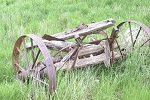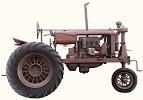


 |
 |  |
Food should be grown on northern, hard clay instead of the sandy soil of California. Not only would the quality be immensely better, reliability would be improved over growing most of the food in one small place, as shown by the drought in California caused by a high pressure air mass parked in one place for five years. There are two major advantages to agriculture in northern, hard clay: One is northern, and the other is hard clay. When the ground freezes in the wintertime, complex nutrients are recycled, as ice crystals break open most cells in the ground including roots from nonperennial plants, most fungi and most bacteria. The cell debris is recycled by a bacterium called Pseudomonas fluorescens and similar bacteria. Approximately all bacteria and yeasts recycle nutrients as they die off through a process called autolysis. It means self-splitting. The cells contain enzymes that reduce proteins to amino acids and genetic material to nucleosides. These monomers are ideal nutrients for everything else growing in the soil including agriculture products. The result is observed as this: As crops emerge in the spring, they start to turn yellow, which indicates a shortage of nitrogen, because bacteria growing on cell debris hog up the nitrogen. These bacteria are very symbiotic; so when the plants get about eight inches tall, they turn dark green, as the bacteria autolyze and provide the nutrients to plants. These monomers—amino acids and nucleosides—are ideal for plants, because then they don't have to synthesize them from scratch. So plant growth is much more rapid and hardy. Garden food growing that way has immensely more flavor and quality than store-boughten food. South Dakota raises the world's sweetest watermelons and muskmelons for this reason. The rinds are about as flavorful as the centers of other melons. Hard clay is immensely superior for agriculture than the sandy soil of California. One reason is because of increased capillary action, which causes water and nutrients to move toward the roots instead of requiring the roots to grow toward the water and nutrients. The increased capillary action produces rapid and high quality growth. Carrots and beets grow in two weeks from seeds to eating. A large amount of water for irrigation would be available from the Missouri River which runs through the Dakotas and Nebraska, except that it is being used for barging on the lower Mississippi River. When the water level is down on the Mississippi, the dams in South Dakota are drained for barging, as the Mississippi is kept about ten feet higher than normal with mini dams and locks for barging. When rains occur along the Mississippi, flooding occurs, because water cannot move rapidly through the mini dams. Barging was archaic two centuries ago. It would be cheaper to send grain from Minneapolis to New Orleans by first class mail when considering the expensive infrastructure and flooding. Parochial interests in the area and entertainment for the Army Corps of Engineers override the rationality. Now the water in the Missouri River will be routinely polluted with oil, as a pipeline going under it will break and dump huge amounts of oil into the river. The Missouri River is about 400 feet below ground level in South Dakota, which means any oil spilled within 20 miles will run into it. The pipeline could have gone around the Missouri River and down the James River valley, as other pipelines do, with no danger to the environment, since that area is totally flat. But activists would not mention it, because they didn't want to be promoting carbon dioxide in the air due to fossil fuels being piped around. So they polluted the last bit of good irrigation water to look at carbon dioxide (out the window) some more.
|
||||||||||||||||
 |
 |
 |